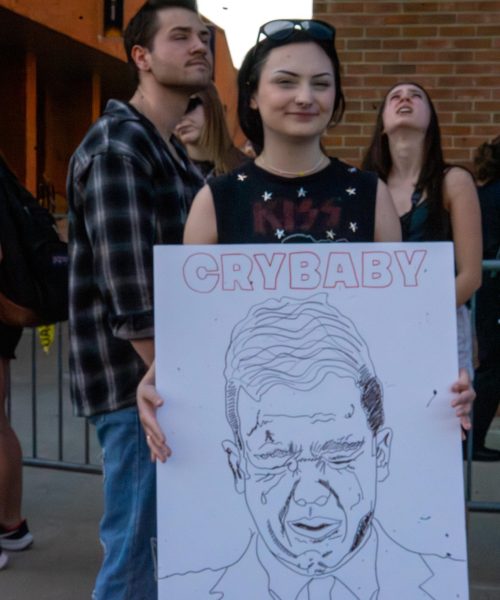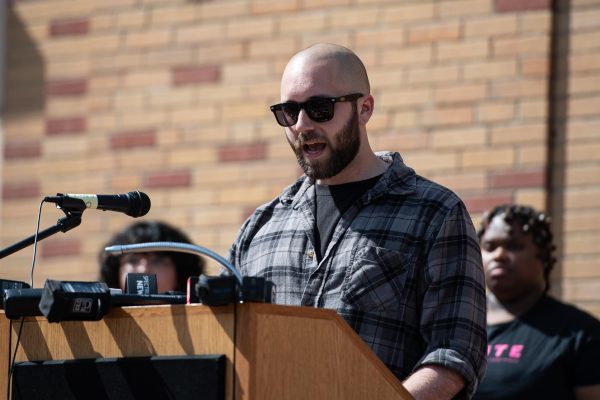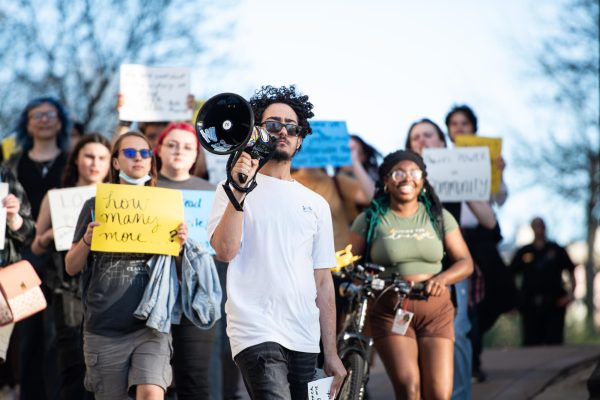Three pieces of art commissioned for ‘Sculpture Mile’
May 6, 2010
Office of the Architect commissioned public art for Esplanade
Art enthusiasts rejoice: Three new public art works will be installed along the Esplanade this summer.
The pieces were commissioned as part of the Percent for Art Program, which requires that 1 percent of state funds of $4 million or more received to build or renovate be used “for the acquisition, commissioning and installation of art work,” according to the Ohio Arts Council’s Web site.
The site goes on to mention that more than 100 projects have been installed under the program, both in major cities and small communities.
Kent State’s own venture, now called the Sculpture Mile, started as the idea of Thomas Euclide, executive director of facilities planning and operation. The Esplanade is currently about half a mile long.
“He got the idea from some things he’d seen in other cities,” said Beth Ruffing, assistant director of capital design and construction.
Ruffing said the Esplanade was ideal for sculptures because there were already several places for them.
Euclide said the long-term goal is to extend the Esplanade to downtown Kent and add pieces along the way.
The extension will make the path about an actual mile, rather than a figurative one.
“It’ll be an exciting way to explore the city and the university by following the artwork back and forth and reading about it and learning about the artists,” Euclide said.
The city of Kent has received a $750,000 grant to offset the cost of extending the Esplanade into downtown, Euclide said. The university is acquiring properties for the extension, but a route has not been chosen.
The Office of the University Architect chose three artists for the Sculpture Mile after narrowing down candidates from those who responded to an announcement seeking applications. The finalists came to the university to develop proposals, and a single artist was chosen for each project.
Ruffing said the “landmark” acquisition of art, which includes more than four other pieces across the campus, will reflect very well on the university as the centennial celebrations draw near.
“The forging of a stronger link between the university and the city will be enhanced by having a walkway that extends in and through the city,” Ruffing said. “And the art will draw people to take that walk.”
‘Star Sphere’
Susan Ewing, associate dean of Miami University’s school of fine arts, is working on “Star Sphere,” a stainless steel sphere comprised of interlocking circles with a star cut out of the center.
“It’s what is removed that has the power,” Ewing said.
Ewing said it’s part of a series on stars. She’s been working with star images for about 13 years, since living in the Czech Republic, where she said stars are featured prominently as decorations.
“Star Sphere” will be placed outside Franklin Hall, the journalism and mass communications building, and will have text pertaining to the first amendment inscribed around its edges.
Ewing said the star is meant to pertain to newspapers, many of which feature the word “star” in their names.
It also relates to the power of photojournalism, which “changed the direction of America” in 1970 after the Kent State shootings.
‘Eye To Eye’
Barry Gunderson, a professor of art at Kenyon College in Gambier, Ohio, is creating “Eye To Eye,” a welded aluminum abstraction of two heads facing each other in deep thought.
“Every public art piece I do, I try to find some relation to the site so it’s not just being plopped into place,” said Gunderson who has been a professional artist for 40 years, teaching at Kenyon for 36.
“Eye To Eye” will be installed in front of the psychology building, Kent Hall, facing Terrace Drive.
Gunderson said in this case, psychology, “where researchers are exploring what goes on in individuals’ minds,” was his influence. In turn, he said, “the subject is also trying to figure out what is going on in the researcher’s mind.”
‘Athleta’
Cleveland sculptor Giancarlo Calicchia, is contributing the third piece, “Athleta,” a carved granite boulder surrounded by smaller stone carvings.
“Athleta,” which Calicchia’s proposal calls a tribute to the ideal of “man and his search for excellence,” is set to be placed south of the Kent Hall addition, ascending the hill toward the water towers.
Calicchia’s proposal described “Athleta” as a representation of the vigor and idealism of the human spirit. He’s been working with wood and stone sculptures for more than 10 years.
“’Athleta’ and its surrounding figures are involved in an emerging narrative which reveals their legacy as the preeminent witnesses of life’s evolution,” the proposal said.
Contact buildings and grounds reporter Aaron Kinney























